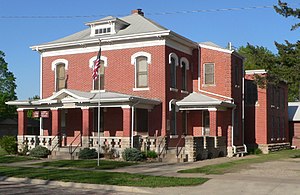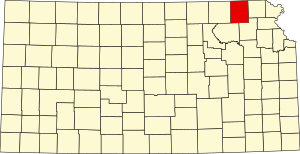Nemaha County is a county located in the northeastern part of the U.S. state of Kansas. Its county seat is Seneca.[3] As of the 2020 census, the county population was 10,273.[1] The county was named for the Nemaha River.
Nemaha County | |
|---|---|
 Jail and sheriff residence in Seneca (2015) | |
 Location within the U.S. state of Kansas | |
 Kansas's location within the U.S. | |
| Coordinates: 39°48′N 96°01′W / 39.800°N 96.017°W | |
| Country | |
| State | |
| Founded | August 25, 1855 |
| Named for | Nemaha River |
| Seat | Seneca |
| Largest city | Sabetha |
| Area | |
• Total | 719 sq mi (1,860 km2) |
| • Land | 717 sq mi (1,860 km2) |
| • Water | 2.0 sq mi (5 km2) 0.3% |
| Population | |
• Total | 10,273 |
• Estimate (2023)[2] | 10,114 |
| • Density | 14.3/sq mi (5.5/km2) |
| Time zone | UTC−6 (Central) |
| • Summer (DST) | UTC−5 (CDT) |
| Area code | 785 |
| Congressional district | 2nd |
| Website | nmcoks.us |
History
editEarly history
editFor many millennia the Great Plains of North America was inhabited by nomadic Native Americans. From the 16th century to 18th century, the Kingdom of France claimed ownership of large parts of North America. In 1762, after the French and Indian War, France secretly ceded New France to Spain, per the Treaty of Fontainebleau.
19th century
editIn 1802, Spain returned most of the land to France, but keeping title to about 7,500 square miles. In 1803, most of the land for modern day Kansas was acquired by the United States from France as part of the 828,000 square mile Louisiana Purchase for 2.83 cents per acre.
In 1854, the Kansas Territory was organized, then in 1861 Kansas became the 34th U.S. state. In 1855, Nemaha County was established.
The first railroad in Nemaha County was built in 1866.[4]
On May 30, 1879, the "Irving, Kansas Tornado" passed through Nemaha county. This tornado measured F4 on the Fujita scale, and had a damage path 800 yards (730 m) wide and 100 miles (160 km) long. Eighteen people were killed and sixty were injured in this tornado.[citation needed]
Geography
editAccording to the U.S. Census Bureau, the county has a total area of 719 square miles (1,860 km2), of which 717 square miles (1,860 km2) is land and 2.0 square miles (5.2 km2) (0.3%) is water.[5]
Adjacent counties
edit- Richardson County, Nebraska (northeast)
- Brown County (east)
- Jackson County (southeast)
- Pottawatomie County (southwest)
- Marshall County (west)
- Pawnee County, Nebraska (northwest)
Demographics
edit| Census | Pop. | Note | %± |
|---|---|---|---|
| 1860 | 2,436 | — | |
| 1870 | 7,339 | 201.3% | |
| 1880 | 12,462 | 69.8% | |
| 1890 | 19,249 | 54.5% | |
| 1900 | 20,376 | 5.9% | |
| 1910 | 19,072 | −6.4% | |
| 1920 | 18,487 | −3.1% | |
| 1930 | 18,342 | −0.8% | |
| 1940 | 16,761 | −8.6% | |
| 1950 | 14,341 | −14.4% | |
| 1960 | 12,897 | −10.1% | |
| 1970 | 11,825 | −8.3% | |
| 1980 | 11,211 | −5.2% | |
| 1990 | 10,446 | −6.8% | |
| 2000 | 10,717 | 2.6% | |
| 2010 | 10,178 | −5.0% | |
| 2020 | 10,273 | 0.9% | |
| 2023 (est.) | 10,114 | [6] | −1.5% |
| U.S. Decennial Census[7] 1790–1960[8] 1900–1990[9] 1990–2000[10] 2010–2020[1] | |||
As of the census[11] of 2000, there were 10,717 people, 3,959 households, and 2,763 families residing in the county. The population density was 15 people per square mile (5.8 people/km2). There were 4,340 housing units at an average density of 6 per square mile (2.3/km2). The racial makeup of the county was 98.35% White, 0.49% Black or African American, 0.23% Native American, 0.10% Asian, 0.06% Pacific Islander, 0.17% from other races, and 0.60% from two or more races. 0.71% of the population were Hispanic or Latino of any race.
There were 3,959 households, out of which 34.00% had children under the age of 18 living with them, 61.90% were married couples living together, 5.10% had a female householder with no husband present, and 30.20% were non-families. 28.00% of all households were made up of individuals, and 16.00% had someone living alone who was 65 years of age or older. The average household size was 2.58 and the average family size was 3.20.
In the county, the population was spread out, with 28.50% under the age of 18, 6.00% from 18 to 24, 24.10% from 25 to 44, 19.40% from 45 to 64, and 22.00% who were 65 years of age or older. The median age was 39 years. For every 100 females there were 97.00 males. For every 100 females age 18 and over, there were 95.10 males.
The median income for a household in the county was $34,296, and the median income for a family was $41,838. Males had a median income of $28,879 versus $19,340 for females. The per capita income for the county was $17,121. About 6.50% of families and 9.10% of the population were below the poverty line, including 9.90% of those under age 18 and 8.50% of those age 65 or over.
Government
editPresidential elections
editNemaha County is strongly Republican. Lyndon Johnson is the only Democrat to have carried the county since 1936.
| Year | Republican | Democratic | Third party(ies) | |||
|---|---|---|---|---|---|---|
| No. | % | No. | % | No. | % | |
| 2024 | 4,555 | 82.91% | 865 | 15.74% | 74 | 1.35% |
| 2020 | 4,664 | 82.05% | 927 | 16.31% | 93 | 1.64% |
| 2016 | 4,124 | 80.52% | 725 | 14.15% | 273 | 5.33% |
| 2012 | 3,930 | 78.19% | 1,000 | 19.90% | 96 | 1.91% |
| 2008 | 3,817 | 71.23% | 1,432 | 26.72% | 110 | 2.05% |
| 2004 | 4,027 | 73.71% | 1,355 | 24.80% | 81 | 1.48% |
| 2000 | 3,578 | 67.64% | 1,494 | 28.24% | 218 | 4.12% |
| 1996 | 3,014 | 56.07% | 1,648 | 30.66% | 713 | 13.27% |
| 1992 | 2,220 | 39.51% | 1,580 | 28.12% | 1,819 | 32.37% |
| 1988 | 2,849 | 54.98% | 2,261 | 43.63% | 72 | 1.39% |
| 1984 | 3,653 | 66.60% | 1,761 | 32.11% | 71 | 1.29% |
| 1980 | 3,546 | 64.99% | 1,600 | 29.33% | 310 | 5.68% |
| 1976 | 2,759 | 50.71% | 2,586 | 47.53% | 96 | 1.76% |
| 1972 | 3,422 | 64.06% | 1,777 | 33.26% | 143 | 2.68% |
| 1968 | 3,003 | 54.01% | 1,925 | 34.62% | 632 | 11.37% |
| 1964 | 2,391 | 42.07% | 3,260 | 57.36% | 32 | 0.56% |
| 1960 | 3,360 | 53.61% | 2,884 | 46.02% | 23 | 0.37% |
| 1956 | 4,195 | 67.11% | 2,038 | 32.60% | 18 | 0.29% |
| 1952 | 5,175 | 75.97% | 1,618 | 23.75% | 19 | 0.28% |
| 1948 | 3,529 | 55.39% | 2,810 | 44.11% | 32 | 0.50% |
| 1944 | 4,277 | 66.44% | 2,149 | 33.39% | 11 | 0.17% |
| 1940 | 5,178 | 65.64% | 2,679 | 33.96% | 32 | 0.41% |
| 1936 | 3,903 | 47.76% | 4,175 | 51.09% | 94 | 1.15% |
| 1932 | 3,167 | 40.60% | 4,578 | 58.69% | 55 | 0.71% |
| 1928 | 4,639 | 61.10% | 2,919 | 38.45% | 34 | 0.45% |
| 1924 | 4,096 | 60.24% | 1,846 | 27.15% | 857 | 12.60% |
| 1920 | 4,655 | 72.32% | 1,731 | 26.89% | 51 | 0.79% |
| 1916 | 3,591 | 49.19% | 3,579 | 49.03% | 130 | 1.78% |
| 1912 | 961 | 22.19% | 1,936 | 44.71% | 1,433 | 33.09% |
| 1908 | 2,394 | 51.57% | 2,182 | 47.01% | 66 | 1.42% |
| 1904 | 2,764 | 61.93% | 1,564 | 35.04% | 135 | 3.02% |
| 1900 | 2,761 | 53.45% | 2,348 | 45.45% | 57 | 1.10% |
| 1896 | 2,568 | 50.49% | 2,478 | 48.72% | 40 | 0.79% |
| 1892 | 2,222 | 49.73% | 0 | 0.00% | 2,246 | 50.27% |
| 1888 | 2,515 | 56.54% | 1,682 | 37.81% | 251 | 5.64% |
Laws
editNemaha County was a prohibition, or "dry", county until the Kansas Constitution was amended in 1986 and voters approved the sale of alcoholic liquor by the individual drink with a 30% food sales requirement.[13]
Education
editUnified school districts
edit- School district office in neighboring county
Communities
editList of townships / incorporated cities / unincorporated communities / extinct former communities within Nemaha County.[14]
Cities
edit‡ means a community has portions in an adjacent county.
Unincorporated communities
edit† means a community is designated a Census-Designated Place (CDP) by the United States Census Bureau.
Townships
editNemaha County is divided into twenty townships. The cities of Sabetha and Seneca are considered governmentally independent and are excluded from the census figures for the townships. In the following table, the population center is the largest city (or cities) included in that township's population total, if it is of a significant size.
See also
edit- Community information for Kansas
References
edit- ^ a b c "QuickFacts; Nemaha County, Kansas; Population, Census, 2020 & 2010". United States Census Bureau. Archived from the original on August 18, 2021. Retrieved August 18, 2021.
- ^ "Annual Estimates of the Resident Population for Counties: April 1, 2020 to July 1, 2023". United States Census Bureau. Retrieved March 24, 2024.
- ^ "Find a County". National Association of Counties. Retrieved June 7, 2011.
- ^ Blackmar, Frank Wilson (1912). Kansas: A Cyclopedia of State History, Volume 2. Standard Publishing Company. pp. 345.
- ^ "US Gazetteer files: 2010, 2000, and 1990". United States Census Bureau. February 12, 2011. Retrieved April 23, 2011.
- ^ "Annual Estimates of the Resident Population for Counties: April 1, 2020 to July 1, 2023". United States Census Bureau. Retrieved April 3, 2024.
- ^ "U.S. Decennial Census". United States Census Bureau. Retrieved July 27, 2014.
- ^ "Historical Census Browser". University of Virginia Library. Retrieved July 27, 2014.
- ^ "Population of Counties by Decennial Census: 1900 to 1990". United States Census Bureau. Retrieved July 27, 2014.
- ^ "Census 2000 PHC-T-4. Ranking Tables for Counties: 1990 and 2000" (PDF). United States Census Bureau. Archived (PDF) from the original on March 27, 2010. Retrieved July 27, 2014.
- ^ "U.S. Census website". United States Census Bureau. Retrieved January 31, 2008.
- ^ "Dave Leip's Atlas of U.S. Presidential Elections".
- ^ "Map of Wet and Dry Counties". Alcoholic Beverage Control, Kansas Department of Revenue. November 2006. Archived from the original on October 8, 2007. Retrieved December 28, 2007.
- ^ a b "General Highway Map of Nemaha County, Kansas" (PDF). Kansas Department of Transportation (KDOT). January 2010. Archived (PDF) from the original on May 28, 2024.
- Notes
Further reading
edit- Atlas of Nemaha County, Kansas; Anderson Publishing Co; 62 pages; 1922.
- Plat Book of Nemaha County, Kansas; A.R. Stinson; 53 pages; 1908.
External links
edit- County
- Other information
- Maps